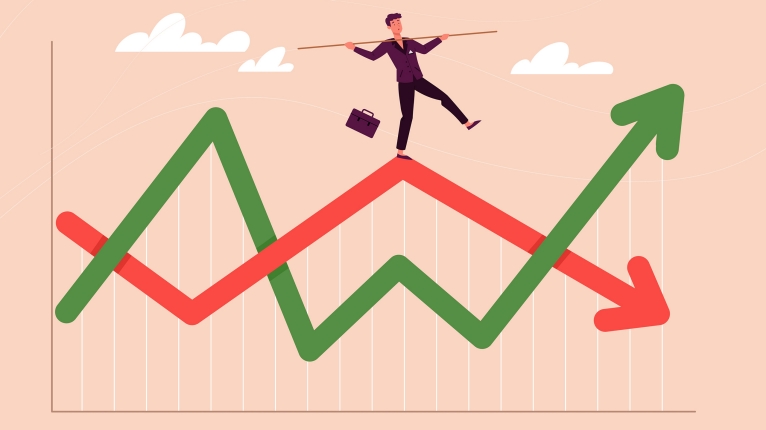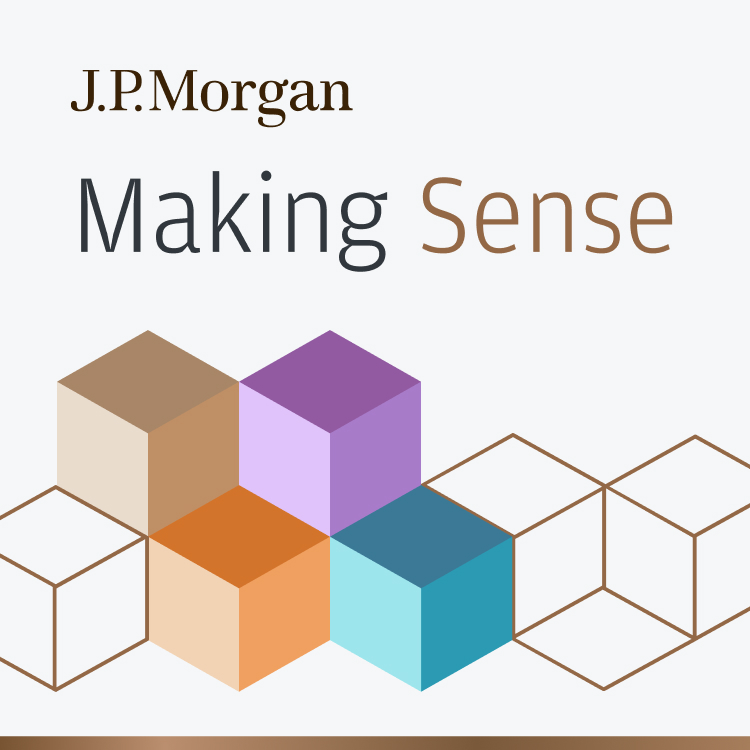11:26
Unlocking the power of people-enabled businesses post-pandemic
This podcast explores the latest trends in the business services sector, including labor challenges, digital transformation, consolidation strategies and more.
Listen nowFrom startups to legacy brands, you're making your mark. We're here to help.
Key Links
Prepare for future growth with customized loan services, succession planning and capital for business equipment.
Key Links
Institutional Investing
Serving the world's largest corporate clients and institutional investors, we support the entire investment cycle with market-leading research, analytics, execution and investor services.
Key Links
Providing investment banking solutions, including mergers and acquisitions, capital raising and risk management, for a broad range of corporations, institutions and governments.
Key Links
A uniquely elevated private banking experience shaped around you.
Whether you want to invest on your own or work with an advisor to design a personalized investment strategy, we have opportunities for every investor.
Explore a variety of insights.
Key Links
Insights by Topic
Explore a variety of insights organized by different topics.
Key Links
Insights by Type
Explore a variety of insights organized by different types of content and media.
Key Links
We aim to be the most respected financial services firm in the world, serving corporations and individuals in more than 100 countries.
Key Links

FICC Market Structure: The outlook on ESG with Chuka Umunna
[MUSIC]
Intro: Welcome to Market Matters, our markets podcast on Making Sense, the hub for J.P. Morgan Corporate and Investment Bank podcasts. In this episode of Market Matters, we'll hear from the FICC Market Structure team. They'll be talking about some of the regulatory initiatives and microstructural developments on our radar, which could shape market liquidity in the fixed income, currency, and commodity markets.
Kate Finlayson: Hello. I'm Kate Finlayson, Global Head of FICC Market Structure at J.P. Morgan. Today, we're going to be taking a look at the integration of ESG in markets. Investors are increasingly conscious of environmental, social, and governance issues. There are also various factors influencing the adoption and approach to ESG in financial markets. To discuss some of these dynamics, I'm delighted to be joined by Chuka Umunna, EMEA Head of ESG at J.P. Morgan. Welcome, Chuka.
Chuka: Thanks very much for having me.
Kate Finlayson: ESG as a theme has certainly made its way into mainstream finance, especially over the last two years or so. We've witnessed a growing focus by firms on incorporating ESG objectives into their investment strategies, as well as policy initiatives to further spur the growth. Where are we at now?
Chuka Umunna: Well, I think that's a great question because I think it invites us to consider what do we mean when we talk about ESG integration and sustainability? Because the two things are quite different, and what has evolved is the use of ESG integration in making investment decisions to, if you like, enhance traditional financial analysis. You're essentially looking when you're considering ESG integration at how the C-suite of the issuer has managed those factors, the environmental, social, and governance factors and the different subset of factors within each strand to promote the financial performance of the business, to improve profitability, to increase revenue, looking towards long-term value creation. Now that's a very different thing compared to, say, looking for a sustainable outcome, where you may not only be looking for a return, but looking at how the business has helped deliver on a societal factor like climate and how it's sought to reduce its carbon emissions, not only for the sake of the financial performance of the company, but for the sake of society as well. So incredibly important to be clear because often these terms get conflated, but they're two different things. It is in the background of why there has been quite a lot of criticism of the ESG investing arena. Then, of course, there is a difference between ESG in the context of a corporate thinking about how to promote profitability as I said, but also it's social license to operate and how it's viewed by external stakeholders and investors deploying different types of strategy which might be negative exclusionary screening or looking to promote a particular outcome or looking at the best-in-class performance from an ESG perspective within an industry group. I think clarity around all of this is really important, but it's here. We have over $7 trillion in assets under management sitting with dedicated ESG and sustainable funds. We don't think that that is going to go in the opposite direction. Assets under management have increased in spite of the challenging times we've had this year. Then there are other things that are driving the growth of this like public policy and consumer retail demands They traditionally did so certainly on the governance side because good ESG integration on the part of the issuer is seen as a proxy for prudent risk management and management of externalities and quality of management.
Kate Finlayson: And what do you believe is driving the continued demand for ESG?
Chuka Umunna: I think there are a number of factors. First of all, the cost of the transition if we are to get to the goal of a net-zero world by 2050. Estimates range between $4 and $7 trillion a year globally every year between now and 2050 and that, in and of itself, means that there's a big role for the financial services sector to play. Secondly, public policy. Public policy helps shape markets. Politicians, those in government, are acutely conscious if they don't act on this. You see things like in various different European countries, bans on petrol vehicles coming into force from 2030, which means that we will be looking to buy different vehicles that help shape markets as a very obvious example, but there are many others too. Consumers, citizens are demanding more sustainable products and services. I think the juries out on the extent to which they're prepared to sacrifice price and quality in the pursuit of sustainability, but it's clear that if you can deliver a good price and a good service, then sustainability can help impact on consumer preferences. Then, investors, this is a big business opportunity. Necessarily, we are going to have to change the way in which we live, and that means that company and prospective issuer of the future that is first to realize the products and innovation that might actually enable us to hit net zero, which the technological advances are necessary, in addition to reducing emissions, you want to place your bets and place the winning bets before others. There is a demand to find investible product that looks like it's a bankable proposition going into the future. That's not an exhaustive list, but I think there's a combination of some of the factors driving a lot of energy. Excuse the pun in this space.
Kate Finlayson: Chuka, you've just been to COP27. What were some of the major takeaways or themes you saw emerging there?
Chuka Umunna: I think firstly this was seen as an EM, an emerging market COP. This was happening in Egypt, in Africa, and inevitably, there was going to be a focus on the support that is given to developing countries to transition by developed countries. Not least because developed countries are seen to have been responsible for the majority of emissions. Up until this point, of course, more than 65% of emissions now are coming from the developing world. So that was always going to be a focus, and unless the emerging world is assisted to transition, there's probably no hope for the whole of the world to transition, so who pays? Whilst there wasn't much progress towards a goal that already had been set several years ago where the developed world would contribute $100 billion to help pay for the costs of climate mitigation, there was actually progress in accepting the principle that the developed world, which should pay for some of the loss and damage that's caused by the climate change that's already happened. We are now seeing the temperature rise 1.1 degrees above pre-industrial levels on account of the pollution and the emissions that have already gone before. Now whilst the principle was agreed to and was in the final text, how this fund is established, who pays into it, which countries can benefit from it, and the timeframes is all left to be determined at COP28. I think the second thing I would say, the second principle point is there's going to be a lot riding on COP28 because there was a feeling that this COP was on balance, a failure because it didn't deliver a lot of what was being demanded, and there will be an expectation at COP28 that there'll be some progress. Certainly having spoken to some of those involved in organising COP28, I think the other thing that we will see come out of that COP is a lot more focus on innovation and technology, because although reducing emissions is absolutely vital, we're probably unlikely to be able to keep temperature rises to no more than 1.5 degrees beyond pre-industrial levels unless there is big technological innovation. This is one of the reasons why here at J.P. Morgan, we have a commitment to facilitate and finance $2.5 trillion to deliver against UN Sustainable Development Goals but also of that $2.5 trillion is dedicated to helping finance climate solutions, because without that, you don't get the innovation and technological advance.
Kate Finlayson: : Interesting. You mentioned, I guess, this balancing act between the ongoing energy crisis, as well as the growing climate commitments and the net-zero targets, how do you anticipate countries balancing energy supply and climate goals?
Chuka Umunna: I think the two have to go hand in hand. Let's break it down. First of all, if you look at what's happening in the developed world, say, you take the UK, for example. The UK since 1990 has reduced its emissions by 44%. It has a pretty ambitious goal of what it wants to achieve by 2030. I think to reduce it by another 60% at least. But you are not going to be able to do that unless you have the right infrastructure in place, unless you modify your grid system, unless you work out how you're going to store energy, if we are wanting to rely on renewables which have more intermittent energy streams than conventional energy sources, there's a whole transformation that is required for us to be able to do that. It's not as simple as just setting a bunch of targets. Then, of course, in the developing world, where this is going to have a high cost and where they are more aligned in some economies on coal, for them, it's all well and good to demand transition, but if it's going to slow the pace of economic growth which leads to poverty, they don't have the same welfare and social safety systems and support systems that we have in OECD economies. They would argue that that's going to lead to greater mortality and so forth. So balancing these different things is going to be a challenge. As I said, unless we work out the developing world aspect to this conundrum, then there's unlikely to be global progress. This is one of the reasons why here at J.P. Morgan we have a commitment to finance and facilitate $2.5 trillion to deliver against the UN Sustainable Development Goals. A trillion of that is very much targeted at climate solutions, but then you've got to get the sustainable development part of that right if we're to be able to transition in a way that people have been described as just, that we're going at a speed that is something that people can cope with and doesn't have adverse effects on particular parts of the world.
Kate Finlayson: : And if we take this down from country, perhaps to firm level, how can companies look at this dynamic as well, this balance?
Chuka Umunna: : I think you need to consider how these issues play in the context of your firm, and that starts with being clear what your material ESG issues are, which are going to impact on the performance of the company, and that primarily is still the lens through which most investors look at these things. So determining what your material issues are is a starting point. Secondly, you then need to disclose appropriately against those material issues. If you don't have a sustainability report, it might be a good idea to perhaps start to publish an annual one. Does it comply with the global standards and frameworks that have emerged? TCFD, the Task Force on Climate-Related Financial Disclosures is emerging as a global standard alongside the Sustainability Accounting Standards Board, which is in turn being turned into a new global standard policed by an outfit called IASB. You'll learn from ESG and sustainability, it's a veritable alphabet soup of time. [laughter] Then just thinking about what is it as well that investors are going to demand. If you're saying that you are looking to get to net zero by 2050, have you got an intermediate target and has this senior executive compensation plans, is it linked to delivery against that roadmap to where you want to be by 2050? I think probably where investors are likely to go next and already are doing so frankly is looking at your CapEx, and how your CapEx spend measures up against your transition plans, for example. I just talked there about the environmental aspect of this. There's a whole suite of social and governance-related issues which will always be of interest to investors as well.
Kate Finlayson: You mentioned alphabet soup and some bodies that set up. My team covers the topic of transparency in markets quite thoroughly, so from recent proposals to extend and enhance trace reporting for US Treasury transactions to the transparency regime that underpins a consolidated tape in the UK and the EU. On the ESG side, we also have policy initiatives that are driving the disclosures required by firms such as the EU Sustainable Finance Disclosure Regulation. The UK is also consulting on its sustainability disclosure requirements. What should firms consider when thinking about mandatory ESG disclosures?
Chuka Umunna: Well, in an EU context, the sustainable finance disclosure relation is still bedding down and there are parts of it that have been left to the market to interpret, and to some extent, the regulators a bit in the mode of we'll leave it to you to work out all the finer detail, but just make sure you don't get it wrong, which can be a challenge for some of our FICC clients, for sure. We've also got the Corporate Sustainability Reporting Directive, the CSRD, which will apply to large corporates with turnover of more than €40 million in an EU setting. Again, that is still bedding down. There's the SEC climate-related mandatory disclosures and the debate around the extent to which there needs to be disclosures on scope three emissions. Then, of course, here in the UK, we've got a whole other framework as well. Now, if you are a multinational business organisation, a bit like J.P. Morgan, you're going to need to make sure you're in compliance with all of these frameworks to the extent that they impact on your business. That's one of the reasons that we have in our global market sustainability centres, in the global markets business at J.P. Morgan, specialist expertise in this area. If you're a corporate, we have an investment banking ESG Solutions team and our Centre for Carbon Transition that advises our clients on these matters because to navigate it is a bit of a minefield, but we have subject matter experts and a multidisciplinary team was there to help you do this.
Kate Finlayson: : Great. In terms of the determination of what is considered green, the EU taxonomy regulation looks to provide some standardisation there. One of the elements we hear a lot from our clients is the reliance on existing ESG ratings. How can this focus on ratings and other measures help investors decipher which financial products or investments are actually ESG linked?
Chuka Umunna: I think you need to treat ESG ratings with some caution. I think they are useful to investors, and they are increasingly influential, which is why the EU Commission has been consulting on whether or not and how to better regulate ESG raters. The International Organisation of Securities Exchanges is actually campaigning for them to be regulated but not necessarily in the way that some might expect.So a common complaint is unlike your credit rating, where there tends to be more convergence amongst the three main credit raters on how to score an issuer, there was a lot more divergence, and a lot of the impetus for regulation is not necessarily around more uniformity in ratings. It's more around the disclosure of exactly how these ratings are reached, the methodologies. I think with most investors what they tend to do is they will not rely on any particular ESG rating. They will take it into account and put it together with their own desktop research and data to come up with their own proprietary internal rating on a company. [music]
Kate Finlayson: Well, this continues to be a fascinating topic with so many factors influencing how firms integrate these objectives and actually interact in the space. Chuka, thank you so much for your insights today.
Chuka Umunna: Thank you very much for having me.
Kate Finlayson: To our listeners, stay tuned for more FICC Market Structure features on J.P. Morgan's Making Sense channel. Goodbye.
Kate Finlayson: If you're enjoying this conversation, you can subscribe as well as our other podcasts to stay on top of the latest industry news and trends. Follow J.P. Morgan's Making Sense on Apple podcasts, Spotify, and Google podcasts.
[END OF PODCAST]
In this episode, Chuka Umunna, EMEA Head of ESG, speaks to Kate Finlayson, Global Head of FICC Market Structure, about the drivers behind ESG demand, policy to help investors decide what is “green,” emerging themes post COP27 and much more.
4 EPISODES

11:26
Unlocking the power of people-enabled businesses post-pandemic
This podcast explores the latest trends in the business services sector, including labor challenges, digital transformation, consolidation strategies and more.
Listen nowNow Playing

15:28
Data Assets Alpha Group: Assessing risk / reward for Asian equities post a modest pullback
Krupa Patel, Head of International Market Intelligence, is interviewed by Eloise Goulder, Head of the Data Assets Alpha Group.
Listen nowNow Playing

14:53
FICC Market Structure: Our watchlist for 2023
This podcast explores key themes and drivers of market structure change that are likely to be top of mind for buy- and sell-side market participants.
Listen nowNow Playing

00:18:02
The outlook on ESG with Chuka Umunna
How are countries and individual firms balancing climate goals amid the ongoing energy crisis?
Listen nowNow Playing

Markets
Planning techniques in a volatile market
Mar 06, 2024
Estate planning may not be at the top of your mind during times of market volatility. However, careful consideration of the opportunities presented during a market decline, especially when interest rates are low, may help reduce taxes as well as assist in fulfilling estate planning goals.

Markets
The impact of holding a concentrated stock position
Nov 29, 2023
Concentrated stock positions are large holdings that create unwanted risk to your portfolio or may be difficult to sell. This article highlights questions to ask your advisor and yourself if you are considering diversifying your portfolio.

Markets
Market Thoughts: Holding the reins tight
May 23, 2023
Recent abrupt market moves, the U.S. economy stuck in a holding pattern and a bumpy road ahead. Our response: to be even more intentional in our risk taking.
Investing
Quick shot: Resilience, despite new risks
Apr 03, 2023
The first quarter of 2023 is in the books. If you only looked at how markets performed at the index level, you might think that not much happened.

Markets
Leaving LIBOR: A Landmark Transition
Mar 29, 2023
The move away from the London Interbank Offered Rate (LIBOR) is a global phenomenon that has the financial industry mobilizing ahead of a looming deadline.

Investing
How European equities are defying the odds
Feb 10, 2023
The region is getting a boost from improved energy dynamics, China’s rapid reopening, slowing inflation and more — and it’s not all priced in.

Markets
Debt ceiling drama: What you need to know
Jan 20, 2023
Increased volatility could follow as policymakers work on a deal. Meanwhile, keep the focus on your long-term investment plan.
You're now leaving J.P. Morgan
J.P. Morgan’s website and/or mobile terms, privacy and security policies don’t apply to the site or app you're about to visit. Please review its terms, privacy and security policies to see how they apply to you. J.P. Morgan isn’t responsible for (and doesn’t provide) any products, services or content at this third-party site or app, except for products and services that explicitly carry the J.P. Morgan name.
